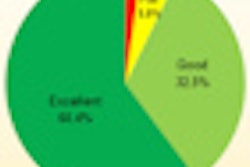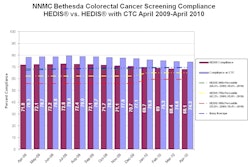The option to have virtual colonoscopy translates into increased compliance with colorectal cancer screening, according to a study presented last week at the American Roentgen Ray Society (ARRS) meeting in Chicago.
Researchers at the University of Wisconsin-Madison found that if the option of virtual colonoscopy (also known as CT colonography or CTC) were not available, nearly one-third of adults screened with the exam would not have had colorectal cancer screening.
The U.S. colorectal cancer screening rate is about 55%, lagging behind other screening tests such as mammography or Pap smears, said lead researcher Bryan Dustin Pooler, and CTC could improve the situation. Therefore, the researchers wanted to evaluate whether the availability of CTC as a screening option affected patients' willingness to undergo colorectal cancer screening. They also wanted to assess patients' attitudes toward CTC as a screening test.
"CT colonography compares favorably to colonoscopy for cancer detection," he said. "Patients tend to prefer it, and it has been shown to be cost-effective as a screening option, if implementing it would substantially increase screening rates."
Pooler's team developed a 10-question survey that focused on patients' willingness to have colonoscopy if CTC were unavailable, their reasons for choosing CTC over colonoscopy, and their personal experience with CTC. In all, 837 patients responded between 2008 and 2010.
Of 833 patients who responded to the survey question of whether they would have had colonoscopy screening if CTC hadn't been available, 267 (32.1%) said "no" or "not sure," Pooler said.
"We actually feel that this probably underrepresents the [number of] patients who would opt to not undergo an invasive screening exam," he said.
Of the 223 patients who had had both CTC and colonoscopy and indicated a preference, 79.8% preferred CTC to colonoscopy. The fact that CTC is not invasive was the main reason cited by patients:
- Noninvasiveness of test -- 67.5%
- Avoidance of sedation, anesthesia -- 64.4%
- Ability to drive oneself home after test -- 52.6%
- Avoidance of colonoscopy risks -- 48.5%
- Possibility of identifying abnormalities outside of colon -- 39.1%
Eighty percent of survey respondents said they would choose CTC for their next colorectal cancer screening, 89.7% described their overall experience as "excellent" or "good," and 92.5% said they would recommend the test to family and friends.
"Patient experience with CTC at our center has been overwhelmingly positive," Pooler said. "Widespread coverage and availability of CTC would have the potential to substantially increase colorectal cancer screening adherence."
Five-year risk? It's low
In a related study, Pooler and colleagues examined the five-year incidence of colorectal cancers following a negative CTC screening exam. They found that colorectal adenocarcinoma rarely occurs in this time frame.
The study included 1,011 patients who had received consecutive negative CTC screening at the University of Wisconsin Health System over a 12-month period. Of these patients, one incident of colorectal adenocarcinoma was found; three additional patients also had significant tumors, including colorectal carcinoid, appendiceal goblet cell carcinoid, and appendiceal mucinous adenoma. All of these patients are alive and undergoing treatment, Pooler said.
Because a positive CTC test is set at a 6-mm polyp threshold, a negative result includes exams with isolated, diminutive polyps, according to Pooler -- those that could progress to colorectal cancer between screenings.
"Critics contend that the practice of ignoring diminutive polyps may lead to high numbers of interval cancers," he said. "[But our study suggests] that the risk is low for interval malignancies with current CTC protocol."



















